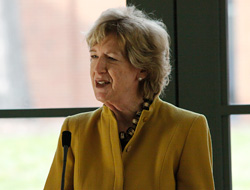Recess Appointments Both Accepted, Controversial
By Tim Arnold

|
Articles II and III of the Constitution are at the root of constitutional questions about recess appointments, Motz said. Article III provides for lifelong tenure and compensation for federal judges, while Article II deals with recess appointments, which are considered temporary pending Senate confirmation.
Lacking tenure, will these judges also lack independence? Are such appointments constitutional?
“The text simply doesn’t yield an obvious answer,” Motz said. However, legislative history provides assistance, she said. Records of the Constitutional Convention and documents such as the Federalist Papers indicate that selection of the federal judiciary was a major concern for the framers, Motz said.
“The convention was split on where to vest the general appointment power, primarily because of the importance attached to the power to appoint judges,” she said.
A compromise was reached to allow for executive nomination and Senate approval. But while Article III generated much debate, Article II was ratified with little debate, she said. The lack of debate is telling, Motz said.
“Given their previous extensive debates as to the appointment of judges, it seems unlikely that they would have intended to exclude judges from the recess appointments clause without discussing and explicitly indicating their intention,” Motz said.
History also bears out the validity of recess appointments, as throughout American historyall three branches of government have accepted that recess appointments are constitutional, she said.
“Beginning with George Washington, almost every president filled judicial vacancies by recess appointments, without suggestion from any quarter that the practice violated the Constitution,” Motz said.
By 2000 U.S. presidents made more than 300 recess appointments and only 34 were not confirmed by the Senate. However, the constitutionality of recess appointments does not make them wise, Motz said.
After President Dwight Eisenhower’s three recess appointments (Supreme Court Chief Justice Earl Warren, and Justices William J. Brennan and Potter Stewart), the Senate Judiciary Committee issued a report saying that recess appointment should only be made under unusual circumstances, Motz said.
Given the political climate, “it seems inconceivable that we will witness a recess appointment of another Supreme Court Justice at any time in the foreseeable future,” she said. The current problem is nominees for other judgeships.
“As of February, 100 judgeships to those inferior courts sit vacant and 47 judicial nominees remain in limbo,” Motz said. But recess appointments “might help break the logjam over pending nominees.” While controversy remains over recess appointments, Motz reminded listeners that these appointments have generally had good results.
“Some of our most distinguished modern-day judges have been recess appointees by both Republican and Democratic presidents,” Motz said, citing Eisenhower’s appointees as examples. “Whatever your politics, these are not political hacks,” Motz said. “Rather, all seem to have had no trouble maintaining the appropriate judicial independence.”
The Ola B. Smith Lecture is sponsored by the Student Legal Forum and the Virginia Law Review.




